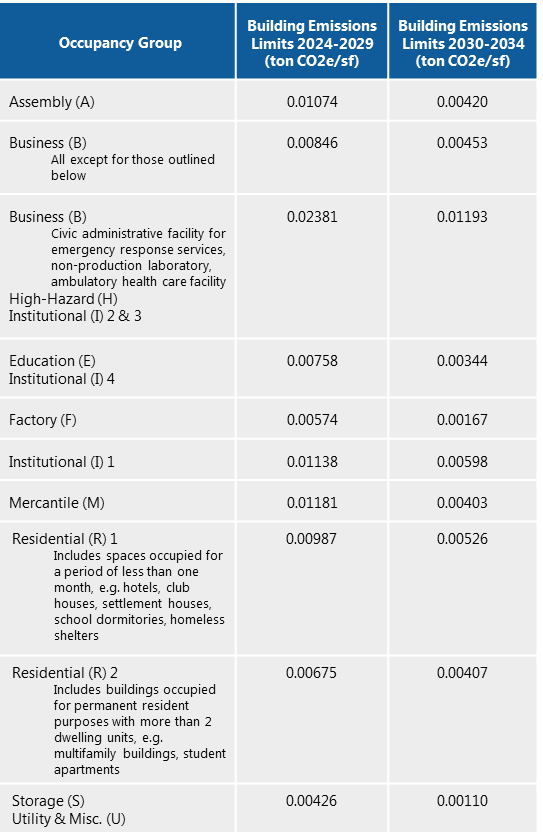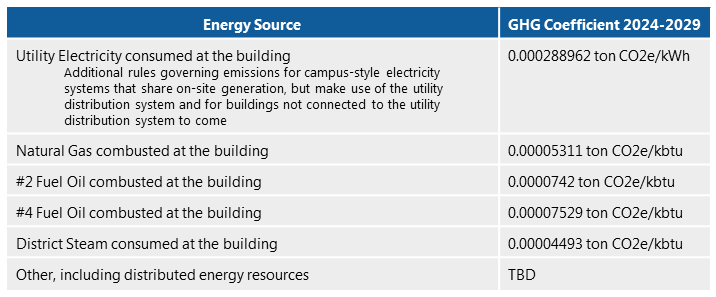Update: The Climate Mobilization Act passed on April 18, which included Int. 1253-C, PACE financing, building efficiency grades, and seven other bills.
As the New York City Council prepares to vote on landmark legislation that would set emissions limits on larger NYC buildings, we felt compelled to dust off our blog from December and update it with the latest from the current version of the bill. The bill is Int. 1253, and the latest version is Int. 1253-C. There are a number of important updates compared to the original bill, including:
- A later initial compliance year of 2024, with the first ratchet to lower emissions levels in 2030.
- Updated emissions limits with added occupancy groups (see Updated Emissions Limits table below) more to account for the different ways in which buildings are occupied and used.
- An “alternative compliance path” for buildings that are more than 40% over their limit, in which they would need to reduce emissions by 30% over their 2018 emissions level.
- Additional and more well-defined exemptions for hardship.
- A list of mandatory prescribed measures in lieu of meeting the emissions limits for exempted buildings, like rent-regulated housing.
- Stipulated emissions factors (see Emissions Factors table below) for different energy types for the first compliance period, to ensure that buildings calculate emissions the same way.
- Locally-produced renewable energy can be purchased as a credit against emissions.
Analysis of the latest limits for multifamily buildings
We revisited the same four multifamily buildings that we analyzed in our previous blog to see how they do under the new version of the bill. Most multifamily buildings are in occupancy group R-2, with emissions factors of:
- 00675/ft2 in 2024-2029
- 00407/ft2 in 2030-2034
First, we needed to recalculate current carbon emissions using the factors in the bill. The results, below, are only very slightly higher (0.5%) than they were in our previous calculations.

Buildings 1 and 2 are both pre-war mid-rise buildings that use gas for heating and hot water, but they perform very differently today. Building 1 is steam-heated but well maintained. A few years ago Building 1 underwent a set of comprehensive retrofits funded in part through NYSERDA’s Multifamily Performance Program (MPP), which cut energy use by over 30%. Building 2 is a high energy user—among the worst 25% of similar buildings in EnergyScoreCards—owing in part to significant overheating and poor control of the heating system. Building 3 is a low-rise building that provides senior housing and was built in the early 80s. Building 4 is a recently constructed high-rise building with a number of high-performance design features including solar PV.
Three of the four are under the 2024-2029 emissions limit today—all they need to do is continue to operate as they have been in order to avoid any fines in the next decade. Building 2 is only 1% over the 2024-2029 limit, and with some simple operational tweaks, could undoubtedly avoid any fines. Regardless, all the buildings must be vigilant about watching their energy usage, and react quickly if it starts going up, or else they could find themselves in for a shock from hefty fines.
The 2030-2034 limits are much lower. Still, buildings 1 and 4 are already in compliance today. And, importantly, Building 1 is steam heated, like so many NYC buildings, proving that it is possible to make a steam heating system operate efficiently enough to meet the 2030 energy savings target (though it may require some careful attention from a steam heating system balancing and retro-commissioning expert). Building 2 would require a 40% reduction in emissions while Building 3 would require 18%. The fines for these two buildings, if they did not make improvements to their energy usage, would be $40k and $30k per year, respectively (note that Building 3 is more than twice the size of Building 2).
For all of these buildings, especially the two that are not yet in compliance for 2030, the owners should carefully consider carbon emissions impacts of any upcoming capital improvement projects. For example, if a boiler or any other HVAC equipment needs to be replaced, swapping the old equipment out for a new version of the same thing is not a good idea—this moment of capital need and expenditure presents an opportunity to select equipment that will have a more dramatic reduction on that building’s emissions. The same is true for roof work, window replacements, lighting, hot water systems, etc. When doing cost-benefit calculations of any building improvements that impact energy use, remember to include a potential emissions fine in future operating costs—in many cases that will make the economics of the more energy efficient option look much better.
And if it feels like a lot to keep track of, don’t worry. NYC is blessed with a mature community of advisors, consultants and experts like Building Energy Exchange and Bright Power that are ready to help building owners understand new local laws and compliance requirements. Bright Power will continue to provide resources to help you get into, or stay in, compliance. We’ve got your back! Just give us a call.
Updated Emissions Limits
Emissions limits vary by occupancy groups. If your building is above the limits listed below, then you will need to identify and install improvements (you may hear engineers or design professionals call them “energy conservation measures”) and make operational changes, and/or purchase or install renewable energy to bring your carbon emissions below the limit. Alternatively, if your building remains above the limit, there will be a fine.

Emissions Factors

For 2030 to 2034, GHG coefficients will be determined by the commissioner with input from the Advisory Board before January 1, 2023.
Another version of this post can be found on Building Energy Exchange’s blog.